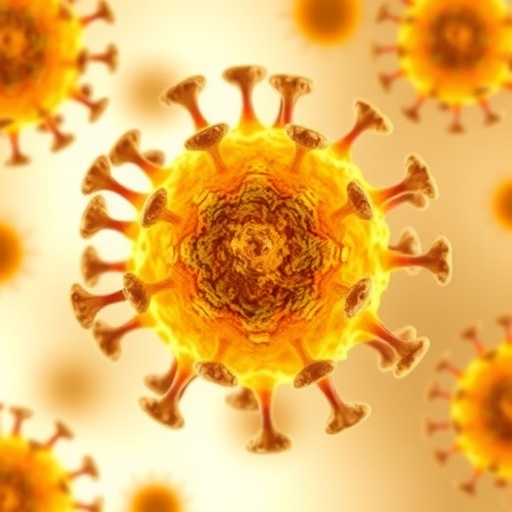The Silent Reawakening: How the Pandemic Masked and Shifted Childhood Viral Immunity Dynamics
In a groundbreaking study published in The Lancet Infectious Diseases on August 6, 2025, researchers unveiled the complex interplay between pandemic interventions and the re-emergence of endemic respiratory viruses in children across the United States. This comprehensive, multicenter clinical trial spanning 2022-2023 offers unprecedented insights into how public health measures enacted to suppress SARS-CoV-2 transmission inadvertently reshaped the immunological landscape among children under ten, leading to a rebound of otherwise routine viral infections at an extraordinary scale.
The study forms part of the Pandemic Response Repository through Microbial and Immune Surveillance and Epidemiology (PREMISE) program, an ambitious research initiative spearheaded by Dr. Daniel Douek at the National Institutes of Health’s Vaccine Research Center. By leveraging longitudinal immunoepidemiological surveillance, this consortium revealed that non-pharmaceutical interventions (NPIs), including masking, social distancing, and enhanced hygiene, profoundly reduced exposure not only to SARS-CoV-2 but also to a myriad of common respiratory pathogens. The data demonstrated a consequential dip in herd immunity, particularly within the pediatric population, who had experienced markedly fewer infectious encounters due to pandemic restrictions.
Central to this investigation was the enrollment and continuous monitoring of nearly 1,000 children across multiple academic sites including the University of Colorado Anschutz Medical Campus, Children’s Hospital Colorado, University of North Carolina, Weill Cornell Medicine, and the University of Alabama at Birmingham. The study employed repeated venous blood sampling to quantify serological evidence of immunity and susceptibility against a broad panel of respiratory viruses. Simultaneously, respiratory samples collected during symptomatic episodes allowed precise pathogen identification and mapped infection histories against immune status.
The findings revealed that the youngest children, particularly those born during or shortly before the pandemic, exhibited markedly diminished antibody levels to viruses traditionally encountered early in childhood. This immunological naivety is directly attributable to the near-cessation of viral circulation during rigorous pandemic mitigation. Once societal measures eased, the data compellingly showed a rapid and widespread resurgence of endemic viral infections, reflecting a significant immunological gap created during the initial pandemic years.
Among the viruses investigated, respiratory syncytial virus (RSV), influenza, and enterovirus D68 (EV-D68) emerged as particularly illustrative examples. EV-D68, a pathogen of heightened concern due to its association with acute flaccid myelitis (AFM), had previously demonstrated unpredictable outbreak patterns. Using the comprehensive PREMISE dataset, researchers retrospectively reconstructed transmission dynamics and, critically, improved the fidelity of predictive models for outbreak forecasting. These models successfully anticipated the sizeable EV-D68 resurgence in 2024, post-pandemic, highlighting the utility of integrated immunoepidemiological surveillance in preempting public health threats.
The implications of such findings are profound. Lead author Dr. Hai Nguyen-Tran emphasized that the extensive biobank compiled through the study—comprising serial blood and respiratory samples—forms a critical resource enabling the acceleration of medical countermeasure development. This ‘on-the-shelf’ repository fast-tracks investigations into antibody treatments and vaccine candidates beyond SARS-CoV-2, essentially furnishing researchers with foundational immunological data to confront future viral threats more effectively and swiftly.
Further, the study underscores an essential paradigm shift: understanding population-level immunity necessitates constant surveillance that extends beyond acute outbreak response to encompass long-term immune landscape monitoring. The ability to map precisely which viral epitopes elicit durable protective immunity guides rational design of next-generation vaccines and monoclonal antibodies. Such targeted immunotherapies may simulate natural immunity profiles most adept at neutralizing pathogens, thus optimizing vaccine efficacy and therapeutic potential.
From a methodological perspective, the longitudinal nature of PREMISE, spanning multiple seasons and encompassing diverse geographic regions, offers an unparalleled vista into the natural history of endemic respiratory diseases amidst unprecedented pandemic disruption. The data highlight how interventions designed for one viral threat exert cascading consequences on the immunological ecosystem, sometimes generating heightened vulnerability to other pathogens upon relaxation of measures.
Additionally, the study’s findings highlight the necessity to balance infection control policies with maintaining adequate immune system priming in children. Public health decision-makers must consider the immunological ripple effects of extended NPIs, especially concerning the timing and nature of relaxing such measures, to mitigate the risk of simultaneous or sequential viral epidemics intensified by population immunity “holes.”
Dr. Kevin Messacar, principal investigator and infectious disease specialist, stressed the collaborative triumph this research exemplifies—melding NIH scientific expertise with frontline clinical research from academic pediatric centers. This synergy is not only advancing fundamental understanding but also actively translating knowledge into public health interventions, such as bespoke vaccines and monoclonal antibodies tailored to evolving viral threats.
Funding for the PREMISE study derives from a subcontract with Frederick National Laboratory for Cancer Research under NIH auspices, totaling $7.98 million over five years. The absence of nongovernmental funding sources further emphasizes the commitment of public institutions to generate open, unbiased data critical for safeguarding population health.
In closing, the PREMISE study represents a pivotal leap forward in infectious disease epidemiology and vaccinology. The ability to detect subtle shifts in population immunity and anticipate viral re-emergence equips the medical community with a strategic advantage in pandemic preparedness and routine infectious disease management. As the world navigates the post-COVID-19 era, harnessing such robust immune surveillance will be indispensable in preempting the next viral storm before it unleashes widespread morbidity among vulnerable populations, especially children.
Subject of Research: People
Article Title: Dynamics of endemic virus re-emergence in children in the USA following the COVID-19 pandemic (2022–23): a prospective, multicentre, longitudinal, immunoepidemiological surveillance study
News Publication Date: 6-Aug-2025
Web References:
- The Lancet Infectious Diseases Article
- DOI: 10.1016/S1473-3099(25)00349-4
- PREMISE Program – NIH NIAID
- Children’s Hospital Colorado
References:
Dynamics of endemic virus re-emergence in children in the USA following the COVID-19 pandemic (2022–23): a prospective, multicentre, longitudinal, immunoepidemiological surveillance study. The Lancet Infectious Diseases. Published 6-Aug-2025. DOI: 10.1016/S1473-3099(25)00349-4.
Keywords: Infectious diseases, Viral infections, Virology, Respiratory disorders, COVID-19, Disease outbreaks, SARS CoV 2, Social distancing, Vaccine research




